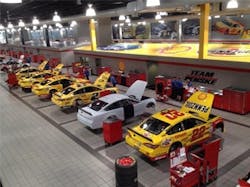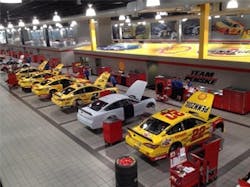Team Penske's secrets of success
Team Penske. To IndyCar and NASCAR racing fans, these two words evoke images of speed, quality, efficiency, and derring-do. And its headquarters in Mooresville, North Carolina, is as hallowed as pole position at Sonoma Raceway.
With 25 national championships, 15 Indy 500 victories, and more than 380 major wins, Team Penske (www.teampenske.com) is the face of an $18 billion Penske organization (www.penske.com) with four core groups — automotive, transportation, performance, and strategic investments.
I recently attended SKF Technical Day, an annual look at the latest innovations from SKF (www.skf.com), and this year it was hosted by none other than one of its strategic partners, Team Penske, with around 350 employees, including more than 40 degreed engineers on staff. Its NASCAR division builds around 50 cars annually. “We build very specialized cars with 900 hp that get 4 mpg,” explained Travis Geisler, Team Penske’s director of competition, who spoke extensively at the event.
“I oversee all things NASCAR,” he said. “I oversee the crew chiefs and try to manage the drivers as best I can.” Geisler is the liaison from the racetrack back to the shop, which just happens to be a 420,000 sq ft facility.
Every Team Penske department — race teams, engineering, assembly, fabrication, and marketing — must outperform the competition. “We get a final exam every week,” said Geisler. “We pretty much know right away if something worked.”
Certain areas are critical to success in the race world. “Development is the key,” he advised. “Every week, the bar ratchets up. People are a huge part of that. You can hire 10 more people and not be as effective as getting more from your employees. Outsourcing is important. We used to have our own complete engine shop. We had an opportunity to partner with Roush Yates Engines (www.roushyates.com). Their 100 employees are now working for us. You give up some of your IP and your advantage, but at some point it will happen. We keep inside the things that we are the best at.”
The facility uses robotic welding, but not for its traditional advantages in mass production. “We use it for the speed, not the efficiency,” explained Geisler. “Once it's cleared by engineering, the robotic welder can finish that part in a half day, instead of a day-and-a-half.” Speed is everything. “We measure dollars in tenth-of-a-lap time to quantify gains in the common unit,” said Geisler. “We use simulation daily.”
Partnerships are important to Team Penske’s winning ways, and SKF’s contributions have led to advancements in thermal imaging, bearing grease, and bearing beacon simulation.
“We use infrared thermo to manage extreme temperatures,” explained Geisler. “Understanding where the radiant heat is helps us to understand where everything is coming from. Increased speed and downforce plus less cooling to improve aero performance equals hub failure due to extreme load and temperature. We have more speed and more lead, and it creates more temperature. The bearing grease has helped us a lot. Having better grease allows us to have better downforce.”
With bearing beacon simulation, Team Penske can analyze hp loss in the rear gear and identify each component's contribution to losses. “In one instance, we determined that 90% of loss came from one bearing,” explained Geisler. “We had SKF take a look at the five bearings that make up this chunk. We're using ceramic materials in our bearings more and more. We're able to afford it when we're looking at just one and not five bearings.”
Team Penske also is leveraging the advantages of additive manufacturing. “We have SLS selective layer sintering) and SLA (stereolithography) machines in house,” said Geisler. “We've been printing parts for seven years. We've been printing parts as a mockup. We also use it a lot for short-run parts. We've started to dabble in raceable high-load components. We only race a car two or three times. Cars are so light and fragile that everything moves.”

